Interictal scalp fast oscillations as a marker of the seizure onset zone
- PMID: 21753167
- PMCID: PMC3149155
- DOI: 10.1212/WNL.0b013e318228bee2
Interictal scalp fast oscillations as a marker of the seizure onset zone
Abstract
Objective: This study aims to identify if oscillations at frequencies higher than the traditional EEG can be recorded on the scalp EEG of patients with focal epilepsy and to analyze the association of these oscillations with interictal discharges and the seizure onset zone (SOZ).
Methods: The scalp EEG of 15 patients with focal epilepsy was studied. We analyzed the rates of gamma (40-80 Hz) and ripple (>80 Hz) oscillations, their co-occurrence with spikes, the number of channels with fast oscillations inside and outside the SOZ, and the specificity, sensitivity, and accuracy of gamma, ripples, and spikes to determine the SOZ.
Results: Gamma and ripples frequently co-occurred with spikes (77.5% and 63% of cases). For all events, the proportion of channels with events was consistently higher inside than outside the SOZ: spikes (100% vs 70%), gamma (82% vs 33%), and ripples (48% vs 11%); p < 0.0001. The mean rates (events/min) were higher inside than outside the SOZ: spikes (2.64 ± 1.70 vs 0.69 ± 0.26, p = 0.02), gamma (0.77 ± 0.71 vs 0.20 ± 0.25, p = 0.02), and ripples (0.08 ± 0.12 vs 0.04 ± 0.09, p = 0.04). The sensitivity to identify the SOZ was spikes 100%, gamma 82%, and ripples 48%; the specificity was spikes 30%, gamma 68%, and ripples 89%; and the accuracy was spikes 43%, gamma 70%, and ripples 81%.
Conclusion: The rates and the proportion of channels with gamma and ripple fast oscillations are higher inside the SOZ, indicating that they can be used as interictal scalp EEG markers for the SOZ. These fast oscillations are less sensitive but much more specific and accurate than spikes to delineate the SOZ.
Figures
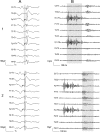
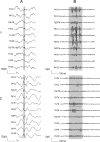
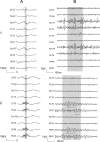
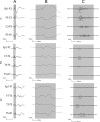
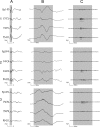
Comment in
-
Extending applications for high-frequency oscillations: the ripple effect.Neurology. 2011 Aug 9;77(6):518-9. doi: 10.1212/WNL.0b013e318228c16f. Epub 2011 Jul 13. Neurology. 2011. PMID: 21753164 No abstract available.
-
Interictal scalp fast oscillations as a marker of the seizure onset zone.Neurology. 2012 Jan 17;78(3):224-5; author reply 225. doi: 10.1212/01.wnl.0000410956.29629.4d. Neurology. 2012. PMID: 22249499 Free PMC article. No abstract available.
References
-
- Bragin A, Engel J, Jr, Wilson CL, Fried I, Mathern GW. Hippocampal and entorhinal cortex high-frequency oscillations (100–500 Hz) in human epileptic brain and in kainic acid–treated rats with chronic seizures. Epilepsia 1999;40:127–137 - PubMed
-
- Bragin A, Engel J, Jr, Wilson CL, Vizentin E, Mathern GW. Electrophysiologic analysis of a chronic seizure model after unilateral hippocampal KA injection. Epilepsia 1999;40:1210–1221 - PubMed
-
- Staba RJ, Wilson CL, Bragin A, Fried I, Engel J., Jr Quantitative analysis of high-frequency oscillations (80–500 Hz) recorded in human epileptic hippocampus and entorhinal cortex. J Neurophysiol 2002;88:1743–1752 - PubMed
-
- Jirsch JD, Urrestarazu E, LeVan P, Olivier A, Dubeau F, Gotman J. High-frequency oscillations during human focal seizures. Brain 2006;129:1593–1608 - PubMed
-
- Crepon B, Navarro V, Hasboun D, et al. Mapping interictal oscillations greater than 200 Hz recorded with intracranial macroelectrodes in human epilepsy. Brain 2010;133:33–45 - PubMed
Publication types
MeSH terms
Grants and funding
LinkOut - more resources
Full Text Sources
Other Literature Sources
Medical
